Art Practice & University Library Printmaking Award
2023/24 Art Practice and University Library Printmaking Award Winner: Christine Santos
Christine Santos, recipient of the 2023/24 Art Practice and University Library Printmaking Award, is a 2024 graduate of the Art Practice Department at the University of California Berkeley. Two of Christine’s prints, Rainbow State Fantasies and Urgent Lexicon Pinay, have been added to the Graphic Arts Loan Collection and can be borrowed by students at UC Berkeley starting this fall.
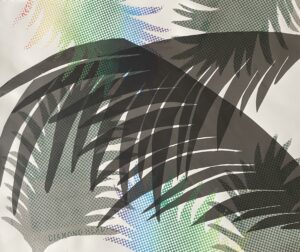
![]()
Below is an Artist Statement from Christine about her work:
I work in digital painting and recently photocopy art, printmaking, and installation. Pulling from state digital archives and my digital snapshots, I digitally manipulate and assemble them to address colonial omission, aesthetic failure, and non-imperial formations. Connections to speculative fiction, DIY culture, cyberfeminism, and Pop Art movement can be made from my work. For example, Archival Densities is an installation series using altered state records from the Digital Archive of Hawai’i to stage fictional events of resistance. I received the AY 2023 – 2024 Center of Race and Gender Student Research Grant to conduct photographic research at Hawai’i’s Bishop Museum to advance my screen print work in Archival Densities. This includes Rainbow State Fantasies, which is now a part of the Graphics Arts Loan Collection.
Rainbow State Fantasies is a screen print monoprint that complicates the popular romanized colonial idea of the “South Seas Island Paradise”. The failed aesthetic of the American curio postcard image of Diamond Head, Hawai’i and suggestive tropical plant silhouettes articulate a visual resistance to this colonial imagination that lingers in Hawai’i’s socioeconomic material culture related to tourism media. Resistance pedagogy and history informs this work as well as Urgent Lexicon: Pinay, the accompanying screen print to this award. Urgent Lexicon: Pinay is inspired by the process of reading Pinay Power by Melinda de Jesus. In this print, I made a handwritten account of the times “pinay” is mentioned and layered it to the point of abstraction.
You can find more about my work here: csantos.xyz
The Art Practice & University Library Printmaking Award is given to the undergraduate student in the Department of Art Practice who has demonstrated an astute understanding of printmaking techniques, as well as an advanced ability to express themselves through the medium of printmaking. This award was established in 2018 by the Department of Art Practice and the University Library, and is given to one or two students each academic year.
2022/23 Art Practice & University Library Printmaking Award Winner: Sharon Carlos Vázquez
Sharon Carlos Vázquez, recipient of the 2022/23 Art Practice & University Library Printmaking Award, is a 2023 graduate of the Art Practice Department at the University of California Berkeley. Two of Sharon’s prints, Cuarto 3/4 and Cuarto 4/4, have been added to the Graphic Arts Loan Collection and can be borrowed by students at UC Berkeley starting this fall.
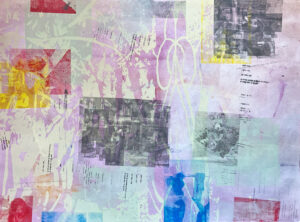
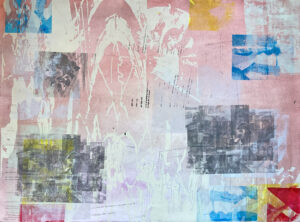
Below is an Artist Statement from Sharon about her work:
My recent body of work explores familial relationships, domestic space, location, the senses, and the abstract nature of memory as it dilutes through time. I view the physicality of my process in printmaking as a method of conversation. This layering allows me to translate, redact, and deconstruct dialogue into gestural imagery and color, which I often literally separate into smaller pieces. Through these techniques, I re-envision memories, blurring the line between concrete, mundane and intangible. My home, often featured abstractly in this work, is a literal container for these images, both public and private
My process revolves around the notion of developing a sense of ‘public privacy’. I accomplish this through the physical printing process, which involves overlayering and obscuring the underlying information. My approach allows for the information to be given a physical space while also challenging its comprehension. My concept takes inspiration from the architectural structure of my home, as well as the topography and land. These fundamentals serve as a foundation for building and layering imagery and textures. Through an additive method akin to redaction, the original and literal imagery is transformed into a distorted representation.
The Art Practice & University Library Printmaking Award is given to the undergraduate student in the Department of Art Practice who has demonstrated an astute understanding of printmaking techniques, as well as an advanced ability to express themselves through the medium of printmaking. This award was established in 2018 by the Department of Art Practice and the University Library, and is given to one or two students each academic year.
2021/22 Art Practice & University Library Printmaking Award Winner: Vera McBride
Vera McBride is a 2022 graduate of the Art Practice Department at the University of California Berkeley, and as the winner of the 2021/22 Art Practice & University Library Printmaking Award, two of Vera’s prints, Sinking and Trick of the Eye, have been added to the Graphic Arts Loan Collection that students at UC Berkeley can now borrow.
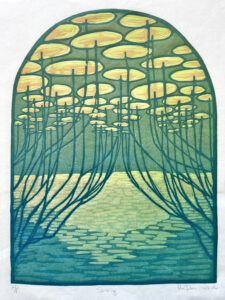
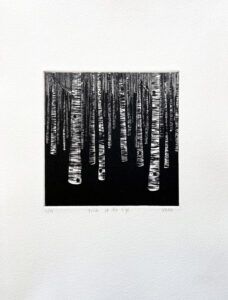
Below are some thoughts on the prints and printmaking from Vera:
My work largely reflects a preference for process and materiality. Even if I’m not patient, the process of printmaking forces me to be, and in turn I spend more time considering the making and fine tuning for the next step and the next piece.
Topically, my body of work has been focused on a blending of daydreams, memories, and experiences. These have been the core generative concepts behind the works, and while some end up as whimsical musings, others are more literal and technique driven with a specific moment referenced. The pieces often have repetition and pattern in some capacity, either within the work itself or reworking a concept across many pieces.
The Art Practice & University Library Printmaking Award is given to the undergraduate student in the Department of Art Practice who has demonstrated an astute understanding of printmaking techniques, as well as an advanced ability to express themselves through the medium of printmaking. This award was established in 2018 by the Department of Art Practice and the University Library, and is given to one or two students each academic year.
2020/21 Art Practice & University Library Printmaking Award Winner: Ezra Sato
Ezra Sato is an Art Practice major at the University of California Berkeley. His visual and written work is often experimental and emerges from a desire to play— of wanting to entertain himself throughout the process and to engage with his prospective audience. While he has been drawing from a young age, he started taking it seriously as a practice in high school and has continually worked to maintain that skill.
Two of Ezra’s prints, I MET A GHOST WALKING BACK FROM THE FOG and (Cross-section), have been added to the Graphic Arts Loan Collection, and are available to students at UC Berkeley to borrow. Below are some thoughts on the prints from Ezra.

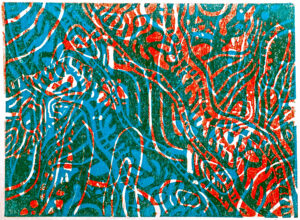
I don’t know that I have much to say about these two prints beyond the fact that I enjoyed producing them and that I hope they can be similarly pleasurable to observe and sit with. The joy of making art, for me, is often in the revisions— when I’m able to hone in on some detail or apply a method that’ll make the image “complete.” Something that I love about the process is that there is a record of the image as it was being worked through in the form of test prints and prior editions. While those artifacts of the process are not available here, please consider what they might be and play around.
The Art Practice & University Library Printmaking Award is given to the undergraduate student in the Department of Art Practice who has demonstrated an astute understanding of printmaking techniques, as well as an advanced ability to express themselves through the medium of printmaking. This award was established in 2018 by the Department of Art Practice and the University Library, and is given to one or two students each academic year.
2019/20 Art Practice & University Library Printmaking Award Winner: Madison Nelson
Madison Nelson is a 2020 graduate from the Department of Art Practice at UC Berkeley. She grew up around horses, and as a result, horses have inspired her from a young age. In her work, Madison aims to capture reality in its purest form through highly rendered, representational drawings. Whereas oil and acrylic paint on canvas informed her work in the past, more recently she has refined her practice to drawing mediums, such as graphite and ballpoint pen, as well as intaglio printmaking. This printmaking technique appeals to her because it requires the artist to patiently plan an entire piece in advance before embracing the many unpredictable outcomes involved in the printing process. Most of Madison’s work is based on photographs she takes, as she believes photography is as close to objective reality as you can get. The translation process from photo to drawing/print then creates an environment in which her viewers can see what she sees, in turn bringing light to parts of reality that are often overlooked.
Two of Madison’s prints have been added to the Graphic Arts Loan Collection, and are available to students at UC Berkeley to borrow. Below are some thoughts on the prints from Madison.
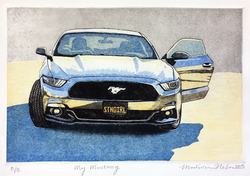
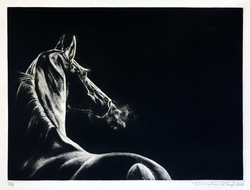
In my two prints, I used subject matter that I am very passionate about: horses and cars. I felt that the Intaglio printmaking process was especially well fit for the image of my personal vehicle because of how much work and planning it took to achieve the final image. Since before I can remember, I had always wanted to own a mustang. With a lot of financial planning and hard work throughout college, I was able to purchase one on my twenty-first birthday. I wanted to commemorate my dedication to achieving that dream with a print of the car. The process and planning it took to reach the final print quite closely mirrors my path to purchasing the real car; for that, this piece holds a special place in my heart and is a reminder to myself that you can do anything you truly put your mind to.
The horse print started out more as an experiment, and having ridden horses for fifteen years of my life, they provided me with a familiar subject that I could comfortably experiment with through a new technique. I put an aquatint on the plate and submerged it in the acid for a full twenty minutes, thereby creating a black print that I then scraped away to reveal the image. This was quite challenging at first because it is difficult to gauge how much pressure is needed to take away the desired amount of the etched surface. Although I am pleased with the final product, I learned how little pressure it takes to achieve more mid-range shades and would go lighter handed the next time I used this method.
The Art Practice & University Library Printmaking Award is given to the undergraduate student in the Department of Art Practice who has demonstrated an astute understanding of printmaking techniques, as well as an advanced ability to express themselves through the medium of printmaking. This award was established in 2018 by the Department of Art Practice and the University Library, and is given to one or two students each academic year.
2018/19 Art Practice & University Library Printmaking Award Winner: Alexandra Grabow
GALC Website
Alexandra Grabow is a fourth year double major in Art Practice and Theater and Performance Studies at UC Berkeley. Even though she took her first art class during her senior year of high school, she has had a drive to create from a young age. As a young girl, Alexandra was taught how to needle point by her mother and quickly became obsessed with the craft; so much so that it has influenced her current work at the university. The block like x stitch of the needle point has grown to become a style of creating images that Alexandra has continued to use in her works. Her unique style can be seen in some of her portraits as well as landscape paintings done during her time at UC Berkeley.
In her fourth semester, and as part of her thesis project, Alexandra wanted to explore how these two forms of creation are connected. Through experimenting with printmaking and needle pointing, Alexandra discovered that the imagery in which these pieces were created were coming from two different forms of memory. After this discovery, Alexandra explored the connection between how the digital world of technology processes memory, and how the human world does it in similar and different ways. In the senior thesis show Alexandra created a free standing frame that depicts a map of how memory is processed and how the types of processing this information weaves in and out of one another. This style has been described by many of her peers and professors as digital or pixelated; however, these descriptions differ from her print work which is described as more organic and atmospheric.
Two of Alexandra’s prints have been added to the Graphic Arts Loan Collection, and are available to students at UC Berkeley to borrow. Below are some thoughts on the prints from Alexandra.
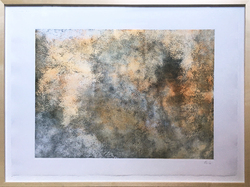
EXPNDS is my latest intaglio series. I am continuing to work with the same types of etching process in previous print series. The reasoning for the title EXPNDS is because I am working with the largest size plate I have ever worked with. As of now this series is a two plate aquatint ground step etching. I have etched each plate once in the acid, with a box dusted aquatint ground. I used the same abstract brush technique to apply the stop out as my other plates, giving it the cloud like texture it has. Some of the prints from this series have been used in other parts of my work, such as my senior thesis project, and will continue to appear in mix media forms of my work.

EXPRMNTS was my first print series that experiment with a new abstract style of printmaking. Instead of trying to recreate imagery from what I saw in reality, I let myself create images that came from places inside my own mind. In many of my other fields I am completely about control and planning, while in printmaking I have been moving away from control and expectations of reality. Not only is the imagery created in this series different from what I have created before, but the process and techniques are also different. This plate series is a three plate aquatint and spray paint aquatint ground step etching. I etched each plate with a box dusted aquatint and used an abstract brush technique when applying the stop out. After the first round of the plates going in the acid, I box dusted the plates a second time and etched them in acid. The last time I sent the plate into the acid, I did a moderate application of the spray paint aquatint. I have printed multiple series of this three plate, three color, print and plan to continue to experiment with the series.